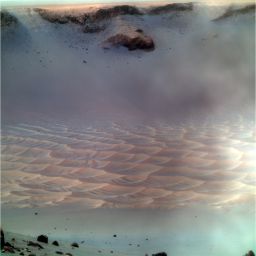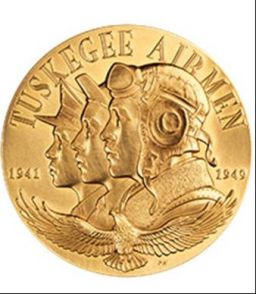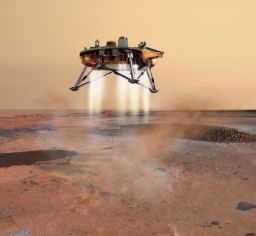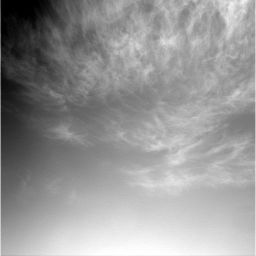A.J.S. Rayl • Feb 29, 2008
The Mars Exploration Rovers Update: Spirit Settles into Winter Spot, Opportunity Descends Deeper into Victoria Crater
With fall slowly passing in the southern hemisphere of Mars and winter looming on the horizon, the Mars Exploration Rovers carried on with business as usual in February, working as much as possible before the reduced sunlight and beyond-frigid temperatures of the dreaded season set in.
At Gusev Crater, Spirit took another series of gradual little "bumps" this month, inching backward and further down the outside slope at the northern edge of Home Plate, nestling into a sweet spot on Valentine's Day where it is now hunkering down to wait out its third winter. Each "bump" or move allowed the solar-powered rover to increase its tilt angle toward the Sun, which continues to move northward in the Martian sky.
Spirit's solar arrays are now tilted at 29.9 degrees, which is about as far as the rover can safely go and still conduct science with its robotic arm, said Jake Matijevic, chief of rover engineering at the Jet Propulsion Laboratory (JPL), where the MERs were designed and are being managed.
"This is where Spirit will be parked through the Martian Winter Solstice on June 26 and for several months afterward," Matijevic confirmed. With its front two wheels resting right on the edge of the circular volcanic formation, the rover almost appears to be hanging onto Home Plate, a visual metaphor of sorts for its bid to survive over the next 7 to 8 months.
Challenges aside, Spirit maintained a respectable science agenda throughout February, making progress with its investigation of the layers or strata of bedrock that form Home Plate. It snapped lots of pictures and also conducted a couple of close-up studies of targets named in honor of the legendary Tuskegee Airmen, the black American pilots who flew the red tail P-51 Mustangs to fame in World War II.
The rover also finished work on Freeman, named after the airfield in Indiana where the famous flyers staged historical protests for civil rights, and began work on Wendell O. Pruitt, named in honor of one of the renowned fighter pilots, who hailed from St. Louis, Missouri. "The focus here is to try and understand the Home Plate stratigraphy," noted Diana Blaney, of JPL, deputy project scientist.
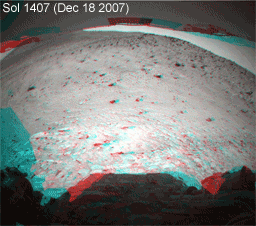 Creeping down Stroupe's Slide (3D)
Creeping down Stroupe's Slide (3D)Over the course of nearly two months, Spirit has been inching its back wheels down from the northern edge atop Home Plate in order to increase the northward tilt of its solar panels, compensating for the motion of the Sun with the approaching winter. As of Sol 1464 (Feb. 14, 2008), the rover's tilt was 29.9 degrees. Use red-blue glasses to see the animation in 3D.
Credit: NASA / JPL / E. Lakdawalla
Once it reached its final parked position, Spirit officially initiated its winter campaign, Blaney added, which includes remote sensing of various features in the area, such as the El Dorado dune field, to see observe changes over the winter months. Interestingly, Spirit also spent time searching for dust devils. "It's well past dust devil season, but we could be surprised," she said. "One of the things we're trying to do is remove some of the systematic biases we've had by only taking data at certain times of day or during certain seasons. This way we'll be able to say there are or were no dust devils with more certainty."
At Meridiani Planum on the other side of the planet, Opportunity finished up its investigation of the region dubbed Lyell, the third layer in the tri-layered rock ring that circles the interior of Victoria Crater by completing its close-up examination of Buckland, its fourth target in the area. From its position there, about 15 meters below the rim, the rover descended approximately 6 more meters (about 19.7 feet) further down the slope toward a layer the team dubbed Gilbert. Keeping with the theme of naming targets in this part of Victoria after famous geologists, Opportunity's destination was named for Grove Karl Gilbert (1843-1918), an American geomorphologist, stratigrapher, structural geologist, and cartographer extraordinaire.
This part of the crater slope features "very sandy" terrain strewn with the tiny spherules known as "blueberries" and Opportunity did have some trouble negotiating it, Matijevic said. "There was some excessive slip on the rocks," he noted, and there was "concern" about making sure the rover could easily get back out again. Since the rover was experiencing considerable sliding, even before it reached the chosen locale, the MER team made a decision to stay on the upper end of Gilbert and investigate another, closer spot the team dubbed Gilbert_A. "After considering this slope and the possible benefits might be of going the extra meter and a half or so to the original target, the decision was made to stay where we are," said Matijevic. "The science team looked around and said -- where we are is good," added Blaney.
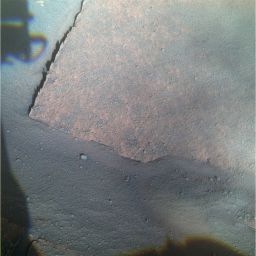 Gilbert
GilbertOpportunity took this image of bedrock within a stratigraphic layer the team named Gilbert, after geologist Grove Karl Gilbert. This is the target the rover was heading for when it experienced considerable slipping and sliding on the sandy terrain. It ended up stopping short of it by about 1.5 meters (4.9 feet) short of the chosen target this month and began investigation of an alternate spot dubbed Gilbert_A.
Credit: NASA /JPL-Caltech / Cornell
The skies above both Gusev Crater and Meridiani Planum cleared a little more from the global dust storm that nearly took Opportunity out last July and overall there was no unexpected change in Mars' weather in February. Images from the Mars Color Imager (MARCI) camera on the Mars Reconnaissance Orbiter (MRO), which is taking broad views of the planet, showed that the weather at both Gusev and Meridiani followed a "fairly predictable pattern in comparison to the rovers' two previous Martian fall seasons," Matijevic said.
Both Spirit and Opportunity are continuing their own routine atmospheric observations in February, measuring the opacity of the skies overhead or tau by taking images of with their panoramic camera (Pancam). At both sites, the tau "fluctuated up and down" as expected throughout the month, ultimately "declining slightly" at both Gusev Crater and Meridiani Planum, Matijevic said. That's good news. The less dust in the sky, the more sunlight fuel is available for the solar-powered rovers. At the same time, however, the amount of sunlight that is able to penetrate the accumulated dust on the solar panels also continued to decline slightly because that which falls from the skies lands on the rovers. As a result, "the energy levels dropped slightly on both Spirit and Opportunity" during the last four weeks, he said.
Spirit's average power levels dropped from 260 watt-hours in January to around 245 watt-hours in February. Nevertheless, the rover managed to maintainits winter schedule of 1.5 hours of daily work each day it works. The goal right now for this rover is survival. "We've got to get Spirit through this winter and it's going to be a tough, tough winter," as lead scientist Steve Squyres, of Cornell University, noted last month. Nothing has changed on that front.
Science collection is still a significant part of Spirit's agenda these days, but as winter comes on, that will change. "We'll continue to plan science tasks up until May, then switch to mostly engineering activities, just keeping it alive, until winter passes," informed Matijevic. Already, Spirit is in a pattern of working for one sol, then taking the next sol off to recharge its batteries, Matijevic said. And because of the reduced data collection and load in the rover's onboard memory system, it is also now downlinking via the Mars Odyssey orbiter on average only once every 3 days. Still, optimism about Spirit's chances for surviving its third Martian winter remain high, Matijevic said, despite the long view predictions that put its chances right on the edge of possibility.
Opportunity, meanwhile, continued generating more power than its twin, but its levels also dropped from an average of 480 watt-hours in January to an average of 430 watt-hours in February. "The Sun is north now and the vehicle is tilted toward south, so this is not unexpected," Matijevic noted. "But the energy levels actually are fine, adequate for doing its investigations." Opportunity put in an average of about 5 hours of science and engineering work each day, much as it did last month. The rover continues to utilize DeepSleep mode, shutting down all systems at night because of the heater that somehow stuck in the "on" position way back when 4 years ago.
Despite the ongoing dust fallout, low power levels and the threat of another Martian winter just around the corner, Spirit and Opportunity remained in good health throughout the month. All was, relatively speaking, quiet on the Martian front and nothing out of the ordinary turn up to thwart the twins as they roved onward in their fifth year of exploring the Red Planet.
Advancing Science
Down on Earth, Spirit and Opportunity drew a crowd in Boston, Massachusetts, at the American Association for the Advancement of Science (AAAS). There, on February 15 MER scientists talked about the rovers' longevity, new observations and recent analyses of some earlier discoveries.
"The engineering efforts that have enabled the rovers' longevity have tremendously magnified the science return," Squyres told the AAAS crowd. "All of Spirit's most important findings, such as evidence for hot springs or steam vents, came after the prime mission," he noted as he has previously in these Updates. Moreover, the ability of the rovers to move from scene to scene has initiated a new era in planetary exploration.
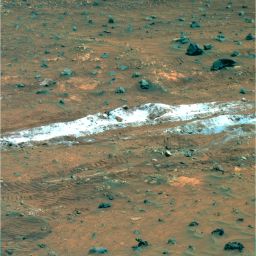 In the Silica Valley
In the Silica ValleySpirit shot this false color image looking toward Silica Valley on Sol 1213 (June 2, 2007)with its Pancam. The false color enhances some of the silica-rich soils the rover studied in the little Valley between Home Plate and Mitcheltree Ridge last year. These silica-rich soils are, perhaps, Spirit's greatest discovery to date and are evidence of past hot springs or fumaroles, both of which would have featured water.
Credit: NASA /JPL-Caltech / Cornell
Squyres also talked about Opportunity's recent investigations of the bright, tri-colored ring of rocks in the inner wall of Victoria Crater. While the MER scientists initially believed that the rock band might preserve a record of the ground surface from just before the impact that excavated the 800-meter (half mile) in diameter hole in the ground, the rover's inspections actually suggest instead that it was at the top of an underground water table, he reported.
Where there is water, there is life. So goes the age-old mantra. That's why over the last decade or so, NASA's Mars missions have been charged with "following the water." But the old mantra, it now appears, may need some tweaking, at least on Mars.
At the AAAS presentation, Harvard biologist Andrew Knoll, a member of the MER science team talked about how they can actually use the MER data to "go beyond saying water was present or absent, to develop some understanding of the properties of water." Knoll and colleagues have been conducting experiments with simulated Martian conditions and computer modeling to refine earlier assessments about whether conditions in the Meridiani area studied by Opportunity would have been hospitable to life. Those studies have been showing that the chances for life evolving on Mars at least at this location -- water or not -- were slim. According to Knoll, not all water may be suitable for life, even extreme life.
During the last couple of decades, biologists have been finding more and more extremophiles thriving in what would appear to be completely unsupportive environments on Earth and in 2000 an international team of researchers sequenced the genome of the first found, Earth bound salt-loving extremophile. However, the area in Meridiani Planum that Opportunity found evidence for an ancient salty sea may have been too salty for even salt loving microbes, Knoll said, its properties "extreme by the standards of terrestrial biology." The story is far from over. The scientific data collected by Opportunity and Spirit will keep scientists on Earth busy for decades to come. And hope for Martian life, past or present, is not lost, not yet anyway. There are other locations still be studied on Mars.
Women Rule
The MER mission, meanwhile, roves on and last Friday, February 22, the team made history in a new way. The entire tactical operations team for the mission, both onsite at JPL and offsite at the various remote institutions, was comprised of women, one of the premiere topics in Emily Lakdawalla's Planetary Society Weblog today. "It was fabulous," admitted Cindy Oda, mission manager. "You know the joke about women drivers. Well, we were joking the whole day -- now women are driving on Mars, commanding rovers."
The gender mix "has changed dramatically" from when Oda first arrived at JPL in 1986. "It used to be primarily men with just a few women. Now there are almost as many women as men," she noted. "It's because JPL has made the effort and encouraged females to go into engineering and that effort has been successful in part because our society has also included more women in the workforce. Also, JPL is particularly good at outreach. A lot of the women here have worked on educational opportunities with women. I've brought my Girl Scout Troop here so they can see what it's like, for example, and a good number of the women on the team are involved with the Pasadena Junior League. JPL also has 'bring your children to work' days and so my daughters have been on Lab and are very involved with the rovers. They know what's going on and know what we do with them."
Truth told, the guys couldn't help but tease the first all-female tactical operations team just a little. "There were a few comments, most soon (and probably best) forgotten," confessed Matijevic.
"We got a lot of good-humored ribbing both ways," Oda revealed. "But I think actually they were quite proud of us. In fact, a lot of them were claiming they wanted to come onboard, because it was all women and it was a cool place to be."
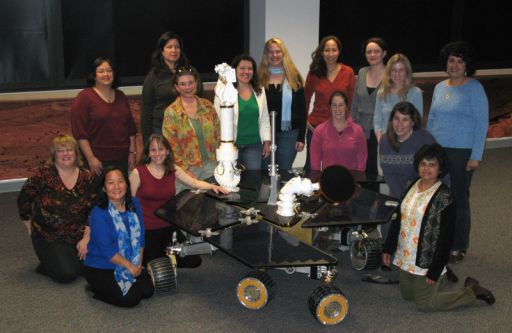 Mars Exploration Rover tactical operations team for February 22, 2008
Mars Exploration Rover tactical operations team for February 22, 2008On February 22, 2008, the entire tactical operations team for the Mars Exploration Rover mission, both onsite at JPL and offsite at remote institutions, was female. Standing left to right:
Cindy Alarcon-Rivera (Security)
Brenda Franklin (Engineering Camera Payload Uplink Lead)
Caroline Chouinard (Tactical Activity Planner / Sequence Integration Engineer)
Sharon Laubach (Engineering Team Lead)
Pauline Hwang (Tactical Uplink Lead)
Colette Lohr (Tactical Uplink Lead)
Tara Estlin (Rover Planner)
Dina ElDeeb (Tactical Downlink Lead / Systems Engineering)
Sitting left to right:
Cindy Oda (Mission Manager)
Ashley Stroupe (Rover Planner)
Julie Townsend (Rover Planner)
Alicia Fallacaro Vaughan (Tactical Activity Planner / Sequence Integration Engineer)
Manju Kapoor (Telecom Subsystem)
All joking aside, it was an historic moment in MER history, not to mention in the annals of planetary exploration. At the end of the day, however, it was really just "a normal planning day," as Matijevic put it. "The participants were all 'regulars' here on MER operations and all were in roles they have commonly worked in the past." And, for all those plagued-by-prototyping people out in the world who may not yet realize it, the days of pocket protectors and slide rules are gone. "Here, the engineers -- men and women alike -- dress the same," noted Matijevic. "Shirts and jeans."
"That prototype of the nerdy scientist and engineers has changed," confirmed Oda. "The women engineers are definitely not nerdy. They're outgoing. Many are world travelers, active in all kinds of sports, whether it's sailing or scuba diving or backpacking or hiking or snowboarding. The engineers and scientists here form a much more diverse group these days. Most importantly, we all love our jobs. We think we've got the greatest jobs in the world."
Spirit From Gusev Crater
Spirit began the month of February at the edge of Home Plate North, where the MER team decided late last year the rover would spend its third Martian winter. As the month progressed, it continued "bumping" or inching its way down the edge of the elevated volcanic plateau to its final and current position, its front wheels right on the rim.
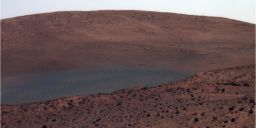 Looking northward
Looking northwardThis is the view that Spirit has looking northward from its position on the edge of Home Plate, where the rover will spend its third Martian winter. Husband Hill is on the horizon. The dark area in the middle distance is the El Dorado sand dune field. The rover used its Pancam to capture this image during its Sol 1448 (Jan. 29, 2008. This image actually combines separate images taken through the Pancam filters centered on wavelengths of 753 nanometers, 535 nanometers and 432 nanometers. It is presented in a false-color stretch to bring out subtle color differences in the scene.Credit: NASA /JPL-Caltech / Cornell
The rover continued routine measurements of atmospheric dust levels or tau by taking skyward images with its panoramic camera (Pancam) and surveying the sky and ground with the miniature thermal emission spectrometer (Mini-TES), as well as checking for drift or changes in time in that highly sensitive, which "reads" the mineral content of soil and rock targets.
As January came to a close and February took hold, the tau at Gusev fluctuated from .40 to .38 and then dropped again to .33. Small changes such as these are typical of sol-by-sol variations during Martian fall and winter, Matijevic noted. Although the atmosphere cleared, ostensibly allowing more sunlight to get to the rover, the dust factor -- an estimate of the amount of sunlight that actually penetrates the layer of dust on the solar arrays -- also dipped slightly and continued to slowly decline throughout the month, effectively canceling out any gain the might have garnered from the skies overhead clearing.
Nevertheless, the dust factor proved "a bit above what we were predicting," Matijevic pointed out, and overall Spirit's power levels have been "fairly stable and drifting down, as expected," decreasing from 260 watt-hours down to 245 watt-hours. "We have seen a little bit of up and down and that too is what we expected," he confirmed.
Despite its low power levels, Spirit managed to pack in a fair amount of science observations during the month of February. In addition to its atmospheric observations, the rover spent as much time as possible focusing on several targets for close-up studies on the Home Plate bedrock on which it is sitting. Each target in the area is being named in honor of the Tuskegee Airmen and places that relate to the high-flying, daring pilots of World War II.
Spirit began February at Freeman, a target on the bedrock near the edge of Home Plate North. The target was named for Freeman Field in Indiana. That's where the Tuskegee Airmen, after fighting for the country and against America's enemies abroad, staged protests for equal rights in 1945. It's also where the Freeman Field Mutiny, a series of attempts by African-Americans in the military to integrate an all-white officers' club, took place. The Tuskegee Airmen and the 10,000 African Americans who served as flight instructors, officers, bombardiers, navigators, radio technicians, mechanics, air traffic controllers, parachute riggers, electrical and communications specialists, laboratory assistants, cooks, musicians, and supply, fire fighting and transportation personnel ultimately paved the way for full racial integration of America's armed forces.
 Tuskegee Pan
Tuskegee PanSpirit finished taking the hundreds of images required to make the Tuskegee Panorama in January 2008 and Jim Bell, the panoramic camera lead, mosaiced those images into the finished product. The rover took the images from Sols 1412 to 1428 (Dec. 23, 2007 to Jan. 8, 2008) as it moved into place off the edge of Home Plate North, its third winter haven. This vantage point provides a particularly good view of the rugged top of Home Plate.Credit: NASA / JPL - Caltech / Cornell
After brushing the surface of Freeman using the wire brush on the rock abrasion tool (RAT) on Sol 1450 (January 31, 2008), Spirit got right to work as the calendar turned. The rover spent its daylight hours on Sol 1451 (February 1, 2008) analyzing the mineral content of the rock in the near distance called Fuzzy Smith using the miniature thermal emission spectrometer (Mini-TES) and on the following sol took measurements of the external calibration target with the Mini-TES, acquiring a 2-by-2-by-5 mosaic of stereo microscopic imager (MI) pictures of the brushed surface of Freeman. The rover then placed the alpha-particle X-ray spectrometer (APXS) on Freeman for an overnight observation to further delineate its makeup.
On Sol 1453 (February 3, 2008), Spirit took measurements of its external calibration target, a rock target known as Winston_Gaskins3, and the background of Fuzzy Smith (the specific target was nicknamed Fuzzy Smith bg2) with its Mini-TES. After sending data to the Odyssey orbiter, the rover spent another 6.3 hours integrating data from the brushed surface of Freeman with the APXS.
Spirit filled out the first week of February completing its study of Freeman, which had stretched over 17 sols, and acquiring full-color images, using all 13 filters of the Pancam of another target on the Home Plate bedrock named in honor of Samuel R. Hughes, a Tuskegee Airman from Los Angeles.
California Congresswoman Diane E. Watson paid tribute to the accomplishments of the Tuskegee Airmen on February 28, 2006, during a debate on the House floor of H.R. 1259, the legislation to authorize the award of the Congressional Gold Medal to these American heroes. In her remarks on the House floor, Congresswoman Watson acknowledged the Tuskegee airmen who reside in her 33rd congressional district of Los Angeles and Culver City, which included Hughes, Wilbert Johnson, William B. Ellis, Elbert T. Hudson, Roger B. Duncan, and Oscar H. York. She also singled out Floyd J. Cawthon, Jerry T. Hodges, Jr., Flora M. Lane, John Lehman, Theodore G. Lumpkin, Jr., and Levi H. Thornhill, who provided ground and logistical support to the airmen and also reside in the 33rd congressional district.
Considered the nation's highest and most distinguished civilian award, the Congressional Gold Medal is awarded to individuals for their outstanding contributions to the nation. The first congressional gold medal was given out in 1776 to none other than George Washington, the country's first President.
On Sol 1458 (February 8, 2008), Spirit began the second week of February acquiring images of the dune field known as El Dorado. "One of the things we're doing in this winter campaign is change monitoring," said Diana Blaney, MER deputy project scientist. "We've decided to look at certain targets as part of this seasonal campaign and El Dorado is one feature that we'll be looking at periodically to see how the dune field changes. It will be one of the targets you'll see over and over again because we will be here a long time."
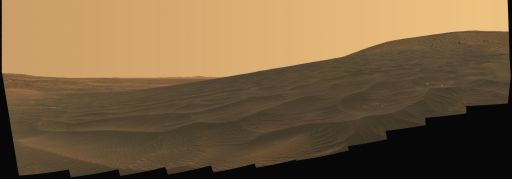 El Dorado
El DoradoSpirit welcomed 2006 by taking this striking panorama of the intricately rippled sand deposits known as El Dorado. This is an approximate true-color rendering of the dune field, which the rover acquired over that New Year's weekend. The view spans about 160 degrees in azimuth from left to right and consists of images the rover acquired with the PanCam on Sols 708 and 710 (Dec. 30, 2005 and Jan. 1, 2006). The rover used the camera's 750-nanometer, 530-nanometer and 430-nanometer filters to capture the colors, while the eliminated seams between individual frames in the sky portion of the mosaic to better simulate the view a person standing on Mars would see.
Credit: NASA / JPL-Caltech / Cornell
That same sol, Spirit also surveyed the Martian horizon, took spot Pancam images of the sky for calibration purposes, and acquired movie frames in search of dust devils using the navigation camera. No one actually expects to see any dust devils this time of the Martin year, but "there is a possibility," said Blaney. "It is late in the season, but the dust storm seems to have changed the dynamics and this is one of the things the science team wants to check out. It's an activity that doesn't take much energy – it's low data rate – and it will fit into those time gaps where it is hard to do anything else," she pointed out.
The team members are still perusing the data and how and if the global dust storm actually did impact the prevalence of dust devils is something of much speculation at this point. Nevertheless, it was peak dust devil season when the big storm turned global last July. And since that storm, the team members really didn't see many dust devils at all. "What we have seen has been at a much lower frequency and rate," Blaney reported. "We're trying to understand if that's real or if we just weren't taking the data at the right time."
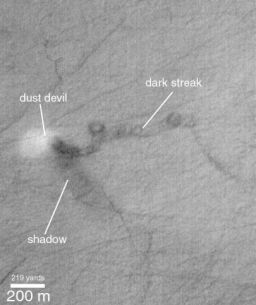 The "smoking gun" dust devil
The "smoking gun" dust devilMany Mars Global Surveyor (MGS) Mars Orbiter Camera (MOC) images of the middle latitudes of the northern and southern hemispheres of Mars showed wild patterns of criss-crossing dark streaks. Some streaks were straight and narrow, others exhibit curly arcs, twists, and loops. They often cross over hills, run straight across dunes and ripples, and go through fields of house-sized boulders. For many months, the MOC science team was uncertain how they formed, although speculation was that they might result from the passage of dust devils. Finally, in December 1999, the team members saw this picture of an event that had occurred just hours before the picture was played back to Earth. It is a "smoking gun" that clearly captured a dust devil making a streak for the first time. Located in Promethei Terra, it was traveling from right (east) to left (west). A columnar shadow, which was cast by sunlight coming from the upper left, indicates the true shape of the dust devil. The dust devil is less than 100 meters (about100 yards) wide and the picture covers an area approximately 1.5 by 1.7 kilometers (about 1 by 1 mile).
Credit: NASA / JPL / Malin Space Science Systems
Could it be that the dust storm usurped the energy needed for the infamous dust devils to form by, perhaps, effectively cooling off the atmosphere? It's an interesting question and one many team members would love too be able to answer.
On Sol 1459 (February 9, 2008), Spirit began the series of small roves to get into its final wintering position, "bumping" 12 centimeters (4.7 inches) further down the north edge of Home Plate.
During the next several sols, the rover acquired mid-field and far-field images with its the Pancam and conducted its regular atmospheric observations. The rover "bumped" another 4 centimeters (1.6-inches) to achieve a northerly tilt of 27.1 degrees on Sol 1463 (February 13, 2008), then used the Pancam to survey the horizon, monitor changes in the El Dorado dune field, and take spot images of the sky.
The following sol, Valentine's Day, the rover bumped another 4 centimeters (1.6 inches), which put it at a 29.9-degree tilt, more than the team had originally planned. The verification of the tilt took place on Sol 1466 (February 16, 2008), said Matijevic.
"It was performed through what we call a quick fine attitude update, which, in essence, makes a visual correction of the inertial measurements unit (IMU) related information," Matijevic said. The IMU is typically the sensor used to detect the tilt of vehicle. "Because there is drift in the measurements of IMU over time, we try to periodically correct that by taking an image of Sun in the sky and working the angles of that through the position of Pancam that took the image to determine what the actual tilt with respect to that position really is. Then that becomes the correction for the attitude," he explained.
The images and estimation onboard verified the 29.9 tilt, Matijevic said. It turned out, Spirit was right on the mark. "When we've done this in the past, we've had to make a small correction of a degree or two," he noted. "This time we did not have to do that."
The very next sol however the tau suddenly spiked to .5 and Spirit's energy dropped to 225 watt hours," Matijevic said. "Over next few sols, the tau decreased and by by Sol 1469 (February 19, 2008) it was back down to 3.7, the level it is now at month's end. "That is consistent with the trend. My estimate -- even when this occurred -- was that this was likely to be a transient event since we're well into the fall season and this is a period of atmospheric stability in the southern hemisphere. Typically, these are simple variabilities around the mean, which is around the orders of .3 to .4 taus and it will be that way all through the winter season." As it turned out, they had no warning or hint from the MARCI on the Mars Reconnaissance Orbiter (MRO). The grand orbiter had a "safeing" event that weekend and the MRO team wasn't in a position to utilize any of its payload, so there were no weather reports for the MER team to review.
 Dust devils in Gusev crater, sol 568
Dust devils in Gusev crater, sol 568Several dust devils are visible in this frame from a movie captured on Spirit's sol 568. Dust devils were observed frequently in Gusev as spring came to Spirit's landing site. Dust devil movies are available on Mark Lemmon's website.Credit: NASA / JPL / Texas A&M
This week, Spirit turned its attention to the next bedrock target, named after Wendell O. Pruitt, This Tuskegee Airman from St. Louis, Missouri is credited with a combat record that included shooting down three German planes, destroying 11 on the ground, and helping to sink an enemy war ship using just machine guns from the air. For his daring, tenacity, and accomplishments, he was awarded the Distinguished Flying Cross with seven clusters. After two months of pre-flight, two months of primary flying, two months of basic flying, two months of advance flying and gunnery school the United States Army Air Corps Flying School at Tuskegee, Alabama, he was commissioned second lieutenant in the class of 42k on December 11, 1942 and was assigned to the 332nd Fighter Group stationed at Selfridge Air Base in Michigan, where fighter training was conducted until the group was shipped to the Mediterranean theater for combat. It was during this tour of combat that Pruitt garnered fame as fighter pilot and was one of the first to complete the 70 missions required for rotation back to the United States. "He was as quiet as could be on the ground, but when he got in the airplane he was a tiger. The best pilot I know," fellow Tuskegee Airman Christopher Newman told KETC-TV in St. Louis.
After returning from combat tours in Italy, Pruitt was killed in a flying accident at Tuskegee Army Air Field in April 1945. He had been training a new cadet when the accident occurred. Speculation holds that the young cadet "froze" during a maneuver and went out of control before Capt. Pruitt could regain control.
The plans now are for Spirit to continue its close-up examination of Wendell_Pruitt for another week or so and carry on with its new, third winter science campaign.
The dust accumulation continues to build up on Spirit's solar arrays. During the final days of February, it has been "around .37," Matijevic offered. "That means only about 37% of the light flows through to the solar array cells to produce power," he expounded. That, however, actually "a little better than what was anticipated" and has resulted in higher absolute values than predicted. The difference isn't great -- maybe 10 to 15 watt-hours, or enough energy to light a 15-watt sewing machine bulb for one hour -- but every bit of power is welcomed with open robot arms.
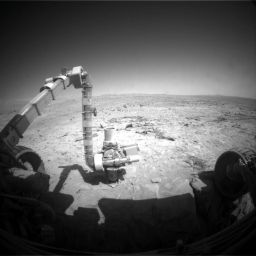 Checking out Wendell O. Pruitt
Checking out Wendell O. PruittSpirit took this image with its front hazcam on Sol 1476 (Feb. 27, 2008 as it was preparing to check out Wendell O. Pruitt, the target named for the famed Tuskegee Airman who flew one of the red tail P-51 Mustangs into World War II history in the 1940s. It shows the rover's final wintering position on the edge of Home Plate North. It will stay here for the next five or six months.Credit: NASA / JPL-Caltech
Throughout the month, Spirit continued averaging a1.5 hour workday per sol worked. The rover continues with its morning, direct-from-Earth uplinks over its high-gain antenna, but because of the winter schedule and the decreasing power availability, its evening data downlinks home via the UHF antenna on the Mars Odyssey orbiter have now been reduced to once every three sols.
"We have gone to the reduced communication schedule and this is consistent with the operational intensity that we're proceeding with here, where we're not actually collecting enough data to make it reasonable to communicate every day," Matijevic explained. "Given the energy levels of vehicle, that's what you have to expect. Every one of the operations takes a sol and then there is a recharge activity in between. So there's a sol on and sol off to recharge. That's the pattern we're into now."
Winter solstice -- the period where the Sun reaches its northern most location -- will arrive in Mars' southern hemisphere on June 26, 2008 when the Sun will be at 25.19 degrees north. For the members of the MER team and the rovers' fans around the world, it can't come soon enough. But once it does arrive, the depths of winter will pass and the picture should brighten considerably for Spirit.
With a total odometry of 7,528.07 meters (about 4.68 miles), nearly 7,000 meters past its "warranty," Spirit wrapped February 2008 in a state of excellent health, with all subsystems generally performing as they should.
Opportunity from Meridiani Planum
Opportunity began February at Buckland, its fourth target in the Lyell region, the third layer of the rock ring or band that circles the interior of Victoria Crater and spent the first week of the month finishing the campaign of scientific investigations of that outcrop target at a spot called site B, among other things.
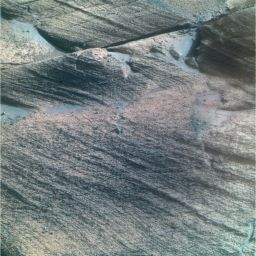 Lyell in living color
Lyell in living colorOpportunity took this image of the bedrock that lies within the stratigraphic layer the team calls Lyell with its Pancam. This is the lowermost of three layers that it has examined in a bright band or ring around the inside of Victoria Crater. The rover captured this image with low-Sun angle at local solar time of 3:21 p.m. during Sol 1433 (Feb. 4, 2008). The pciture actually combines separate images taken through the Pancam filters centered on wavelengths of 753 nanometers, 535 nanometers and 432 nanometers and is presented in a false-color stretch to bring out subtle color differences in the scene.
Credit: NASA /JPL-Caltech / Cornell
In addition to taking panoramic camera (Pancam) measurements of atmospheric opacity caused by the dust in the skies from the global storm in July 2007 , Opportunity averaged about five hours of science for almost every sol it worked and kept its regular communications schedule, receiving instructions directly from Earth via the high-gain antenna and relaying data to Earth later in the sols via the UHF antenna on the Mars Odyssey orbiter.
As the month began on Sol 1430 (February 1, 2008) at Meridiani Planum, Opportunity swung its robotic arm out of the way and took full-color pictures with its panoramic camera (Pancam) using all 13 filters and a 2-by-2-by-14 stack of stereo images of Buckland for eventual 3-D viewing, then went into DeepSleep mode.
The following sol, the rover gleaned enough solar energy to wake up autonomously. Opportunity then used the WATCH sequence of computer commands to hunt for winter clouds above Victoria Crater and acquired movie frames in search of clouds with the navigation camera. Later, it placed the alpha-particle X-ray spectrometer (APXS) on the surface of Buckland and, after relaying data to the Odyssey orbiter, used the instrument to gather data about the rock's elemental chemistry.
Opportunity surveyed the horizon with the Pancam after waking up on Sol 1432 (February 3, 2008) and again spent time scanning the sky for clouds with the navigation camera. The rover also acquired a mosaic of Pancam images of a new area of layered rock named Harland, for British polar geologist W. Brian Harland (1917–2003) and then placed the iron-seeking Mössbauer spectrometer on the surface of Buckland and spent 7 hours studying the target with the instrument.
An esteemed geologist at Cambridge University in England, Harland was one of the first scientists to advocate of the theory of continental drift, which is, essentially the movement, formation, or re-formation of continents described by the theory of plate tectonics. Instrumental in the establishment of the Cambridge Arctic Shelf Programme (CASP), he made the first observations of the global occurrence of glaciation that formed the foundations of the Snowball Earth theory. He was also a key figure in the ongoing maintenance of the International Geologic Timescale. He spent 43 field seasons conducting geological mapping of the Polar archipelago of Spitsbergen, from1938 to the 1980s, leading 29 expeditions. The ice field Harlandisen on the main island of Svalbard is named in his honor. [Source: Wikipedia]
During the ensuing sols, Opportunity acquired mosaics of images of Harland with the Pancam, continued scanning the sky for clouds with the navigation camera, and used the Mössbauer spectrometer to finish its study of the iron content of Buckland, "dropping off" for into a couple of mini-DeepSleeps along the way.
Opportunity also snapped some thumbnail images of the sky, completed a sky survey at high Sun with the Pancam, and exchanged tools to the microscopic imager (MI) to acquire a stack of pictures of Buckland prior to acquiring another stack in search of Martian frost on the rock tailings exposed at Buckland on Sol 1435 (February 6, 2008).
In support of Phoenix, the NASA Scout mission to be managed by the University of Arizona once in lands in May, Opportunity conducted a joint UHF communications test with the Mars Reconnaissance Orbiter on Sol 1436 (February 7, 2008).
That same sol the rover also acquired some more thumbnail images of the sky with the Pancam and again scanned the sky for clouds with the navigation camera, but other plans, including a PanCam survey of the bit on the rock abrasion tool (RAT) and another Mössbauer observation on Buckland did not take place because of a stall in Joint 1, which controls the orientation of the shoulder on the rover's robotic arm. Opportunity, however, managed to close the cover of the MI before going into a deep sleep to end the first week in February.
Opportunity and its ground team at JPL ran the usual diagnostic tests for this sort of fault, which occurred while the rover was checking out Buckland. As the second week of the month got underway, on Sol 1437 (February 8, 2008), the rover successfully placed the Mössbauer spectrometer on the target, but the following sol the rover's handlers decided to not continue with further scientific studies of Buckland. Instead, they instructed the rover to proceed instead with a drive toward Gilbert, a new area of bedrock further down the slope of the crater named for Grove Karl Gilbert (1843-1918), geology's "great engine of research."
A charter member of the U.S. Geological Survey and twice president of the Geological Society of America, Gilbert made fundamental contributions to the geologic history of Lake Bonneville, the glacial geology of the Great Lakes and Alaska, hydraulic mining in California, as well as the fundamental theories of mountain building.
Since the drive down toward Gilbert meant Opportunity would wander into new terrain, the team created a series of steps to allow the rover to characterize the surroundings along the way. One of these steps involved placing the front two wheels on an area of soil to leave a scuff on the surface and backing up to take images of the exposed area.
After recovering from the Joint 1 stall, Opportunity proceeded carefully toward its next target, an exposure of layered rocks the team called Gilbert. The rover's energy was fairly robust at 483 watt-hours. Tau measurements of atmospheric dust, meanwhile, were fairly high at 0.757 but dust factor measurements of sunlight penetration to the solar panels was also at 0.75.
On Sol 1438, however, prior to reaching the intended soil area, Opportunity aborted the drive after 3 meters. The rover back on the course to Gilbert three sols later and on Sol 1441 (February 12, 2008) completed the second planned "scuffing." This time the scuff was a complete success, though it revealed an interesting surprise -- Opportunity's right front wheel dug in much more than expected, highlighting the need to proceed cautiously toward Gilbert.
Since the rover was unable to relay all of the diagnostic data to Earth at one time because the volume of data was more than could be accommodated, the JPL engineers decided that the prudent thing to do was to wait one planning cycle before having the rover proceed with the drive. Therefore, Opportunity spent Valentine's Day, Sol 1443 (February 14, 2008), conducting a diagnostic examination of the grind bit on the rock abrasion tool (RAT) and collecting a mosaic of MI pictures and compositional data with the APXS of Lyell Exeter, the rock area named in commemoration of the college attended by geologist Sir Charles Lyell in the early 1800s. Its power levels dropped to around 469 watt-hours, but the rover still had more than enough energy to carry out is science and engineering tasks.
 Lyell Panorama
Lyell PanoramaDuring four months prior to the fourth anniversary of its landing on Mars, Opportunity examined rocks inside Duck Bay in the western portion of Victoria Crater. The main body of the crater appears in the upper right of this panorama, with the far side of the crater lying about 800 meters (half a mile) away. Bracketing that part of the view are two promontories on the crater's rim at either side of Duck Bay, Cape Verde, about 6 meters (20 feet) tall, on the left, and Cabo Frio, about 15 meters (50 feet) tall, on the right. The rest of the image, other than sky and portions of the rover, is ground within Duck Bay. The rover's targets of study during the last several months are the rock layers within a band exposed around the interior of the crater, about 6 meters (20 feet) from the rim. Bright rocks within the band are visible in the foreground of the panorama. The rover science team named the three subdivisions of the band Steno, Smith, and Lyell, after legendary geologists. This view combines many images Opportunity took with its Pancam from Sols 1332 through 1379 (Oct. 23 to Dec. 11, 2007). Images taken through Pancam filters centered on wavelengths of 753 nanometers, 535 nanometers and 432 nanometers were mixed to produce an approximately true-color panorama. Some visible patterns in dark and light tones are the result of combining frames that were affected by dust on the front sapphire window of the rover's camera.
Credit: NASA / JPL-Caltech / Cornell
On Sol 1446 (February 17, 2008), Opportunity conducted a "backup," as Matijevic called it, for about 1 meter to reposition and align itself with the target. Then, four sols later, on Sol 1450 (February 21, 2008) the rover made one more drive for about 2 meters, but it experienced "excessive slip on the rocks," he said.
"The reason for the drive down to this area being as slow as it was, being partitioned up in so many pieces was so that we could verify each drive and insure the vehicle could back up and get back up the slope and out again," Matijevic explained. "This area is very sandy. There seems to just be more material on the rocks and so there was concern about this creating a slippery terrain."
After a fairly significant sliding event on Sol 1450, the science team members huddled and decided this was a spot that appeared very similar to the original spot chosen on Gilbert. "With the trouble we had getting there, the science team members basically looked around at where we ended up and decided that scientifically it would serve the same purpose as the place we were first trying to get to, so we decided to stay put," confirmed Diana Blaney, deputy project scientist.
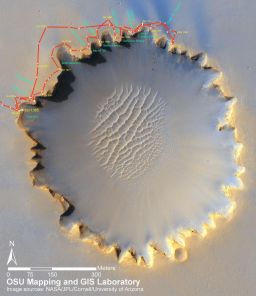 Victoria Crater
Victoria CraterVictoria Crater, which is about 800 meters (one-half mile) in diameter, has been home ground for Opportunity since it first reached the crater's rim on Sept. 27, 2006, on its Sol 951. This view shows its path overlaid on a HiRISE image of the crater from the Mars Reconnaissance Orbiter. The rover "sailed" clockwise about one-fourth of the way around the rim before returning to Duck Bay, the "alcove" where it first roved up to the crater rim. There, on Sol 1293 (Sept. 13, 2007), it began a sustained exploration of a bright band of rock layers that circle the interior of the crater. This map includes the rover's route though Sol 1365 (Nov. 26, 2007). The scale bar is 300 meters (984 feet) long.
Credit: NASA / JPL-Caltech / UAz / Cornell / OSU
"I think we expected this sliding," Matijevic expounded. "A lot of this driving is done with reasonably tightened test parameters or limits making sure every step of the way that we have room for return. If you allowed slips of 60-80%, it's hard to imagine you would get out without having difficulties. There's probably more to give if we really want to go, but the decision was a matter of being cautious."
At the AAAS meeting, MER science team member Andrew Knoll, of Harvard University, talked on February 15 about their studies of Opportunity's findings of past water and what that meant in terms of the properties of the water -- and of life. "At first, we focused on acidity, because the environment would have been very acidic," Knoll said. "Now, we also appreciate the high salinity of the water when it left behind the minerals Opportunity found." Like salt used as a preservative, high concentrations of dissolved minerals in the wet, early-Mars environment known from discoveries by Opportunity may have thwarted any microbes from developing or surviving.
Conditions may have been more hospitable earlier, Knoll qualified, with water less briny. But the later conditions at Meridiani and elsewhere on the surface of Mars appear to have been less hospitable. "Life at the Martian surface would have been very challenging for the last 4 billion years. The best hopes for a story of life on Mars are at environments we haven't studied yet -- older ones, subsurface ones," he said.
In the fall of 2000, an international team of researchers from 11 universities in North America, Canada and the United Kingdom sequenced the DNA in a species of Halobacterium, a microbe known as Halobacterium NRC-1, the first-found, salt-loving extremophile on Earth. These microorganisms are rod-shaped "bugs" not visible to the naked eye and are found in very salty lakes, including the Great Salt Lakes and the Dead Sea, capable of surviving in conditions 10 times saltier than seawater.
Like virtually all extremophiles, Halobacteria are members of an unusual group of organisms called archaea, first discovered, described, and named by the renowned microbiologist-turned-evolutionist Carl Woese, of the University of Illinois at Urbana-Champaign. In his meticulous research into the DNA and RNA of the first extremophiles found on Earth, Woese redrew the Tree of Life to add archaea. Some scientists now believe the archae in existence today actually represent relics of ancient forms of life.
In any case, the genetic research on Halobacterium NRC-1 would no doubt be useful in the investigation into whether Mars once harbored -- or still does harbor -- similar lifeforms. By better understanding halophiles and extremophilic life on this Earth, scientists -- and astrobiologists more specifically -- will be in a much better position to detect life, living or extinct, on other planets.
Despite the discovery and new knowledge about Halobacterium NRC-1 on Earth, the data returned by Opportunity still "tightens the noose on the possibility of life" on Mars, Knoll said. "Halobacter figures into our thinking," the Harvard biologist said via email this week. "Its genome may be new, but its ecological tolerances have been known for years. The water activity we calculate for Meridiani waters at the moment when Mg-sulfates precipitate is just a hair above those tolerated by Halobacter. At the point of halite precipitation, water activity would have been far lower than anything known to be tolerated by Halobacter or any other microorganism on Earth."
At the AAAS meeting, Knoll drove home the point that scientists can use MER data to go beyond just saying water was present or absent and get into teasing out the properties of that water. "Water surely was present when Meridiani rocks formed, but its properties would have been extreme by the standards of terrestrial biology," Knoll expounded for this Update. "Some terrestrial microbes live at pHs comparable to those inferred for Meridiani, but salinity would have been more challenging. Low pH and low water activity? Not a combination we see much on Earth."
Even so, all hope for life, past or present, on Mars is not yet lost. "Observations from Mars Express permit the hypothesis that Mars was more hospitable early in its history," Knoll added. "Tests of this hypothesis are available in the form of Mars Science Laboratory (MSL) -- depending on where it lands."
By month's end, Opportunity's health remained excellent overall, according to Matijevic. Its total odometry was 11,671.23 meters (about 7.25 miles). The rover's power levels dropped further as anticipated, down to 430 watt- hours. "The Sun is north now and the vehicle is tilted toward south, so this is not unexpected," he pointed out. "Even so the energy levels are fine, adequate for doing all the science investigations on its agenda."
The Time is Now.
As a Planetary Defender, you’re part of our mission to decrease the risk of Earth being hit by an asteroid or comet.
Donate Today

 Explore Worlds
Explore Worlds Find Life
Find Life Defend Earth
Defend Earth



